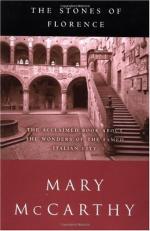
|
| Name: _________________________ | Period: ___________________ |
This test consists of 15 multiple choice questions and 5 short answer questions.
Multiple Choice Questions
1. What is the object that is most frequently stolen in Florence?
(a) Passport.
(b) Bicycle.
(c) Wallet.
(d) Camera.
2. Who is buried in the Badia, an abbey?
(a) Saint Francis.
(b) Gregory the Great.
(c) Michelangelo.
(d) Ugo of Tuscany.
3. As mentioned in Chapter 3, what does the surname "Bevisangue" mean?
(a) "Ruthless."
(b) "Blood-drinker."
(c) "Cold-blooded."
(d) "Goldenhearted."
4. In what period did grotesquerie begin to become present in Florentine art?
(a) The Renaissance.
(b) The Enlightment.
(c) The Middle Ages.
(d) The Romantic period.
5. Which Florentine church is too far outside Florence for most tourists to visit?
(a) The Duomo.
(b) Santa Trinita.
(c) San Miniato.
(d) Santa Maria Novella.
6. As Chapter 2 mentions, what place in Florence "resembles a petrified forest"?
(a) The tomb of San Miniato.
(b) Michelangelo's studio.
(c) The basement of the Duomo.
(d) The butterfly garden at the Boboli.
7. How many arches does the Santa Trinita bridge have?
(a) Four.
(b) Two.
(c) Three.
(d) One.
8. What was the function of medieval towers?
(a) Guest space.
(b) Storage.
(c) Self-defense.
(d) Aesthetics.
9. What is the color scheme of the Baptistery?
(a) Black and white.
(b) Blue and gold.
(c) Pink and brown.
(d) Grey and brown.
10. According to the author, who is the only person who can observe Florence well?
(a) The gatekeeper at the Boboli.
(b) The streetsweepers.
(c) The toddlers in strollers.
(d) The night watchman.
11. Who is the patron saint of Florence?
(a) Saint Jerome.
(b) Saint John the Baptist.
(c) Saint Cecilia.
(d) Saint Augustine.
12. According to the medieval belief, who were the ancestors of the Blacks in Florence?
(a) Jewish astronomers.
(b) Venetian nobility.
(c) Greek scholars.
(d) Roman soldiers.
13. Which group of people most commonly gets robbed in Florence?
(a) Americans.
(b) Italians.
(c) Germans and Swedes.
(d) Greeks.
14. Which famous Florentine statue no longer has a head?
(a) Dawn.
(b) David.
(c) Primavera.
(d) La Dama del Alba.
15. From where did the stone for the Santa Trinita bridge come?
(a) The quarries to the north of the city.
(b) Alexandria.
(c) Rome.
(d) The Boboli Garden.
Short Answer Questions
1. Which poets touted a "tooled-leather idea of Florence as a dear bit of the old world"?
2. What is Donatello's statue of John the Baptist as a boy called?
3. According to Chapter 1, how much did the piece of masonry that fell from the National Library weigh?
4. According to Chapter 2, by the time Michelangelo was an old man, who could afford to commission a work from him?
5. As mentioned in Chapter 1, what injury was suffered by the woman who was hit by two bicycles?
|
This section contains 417 words (approx. 2 pages at 300 words per page) |

|




